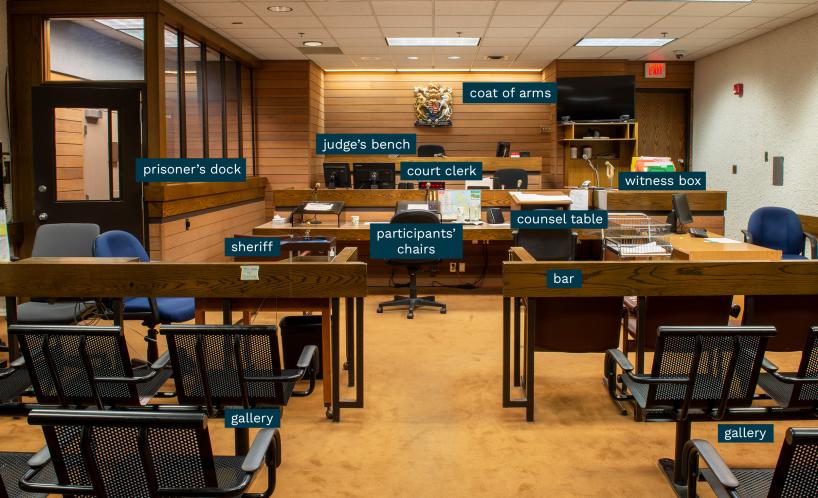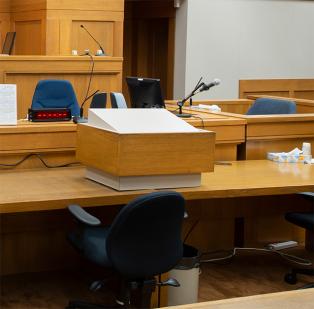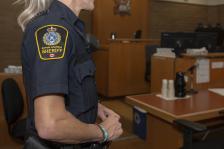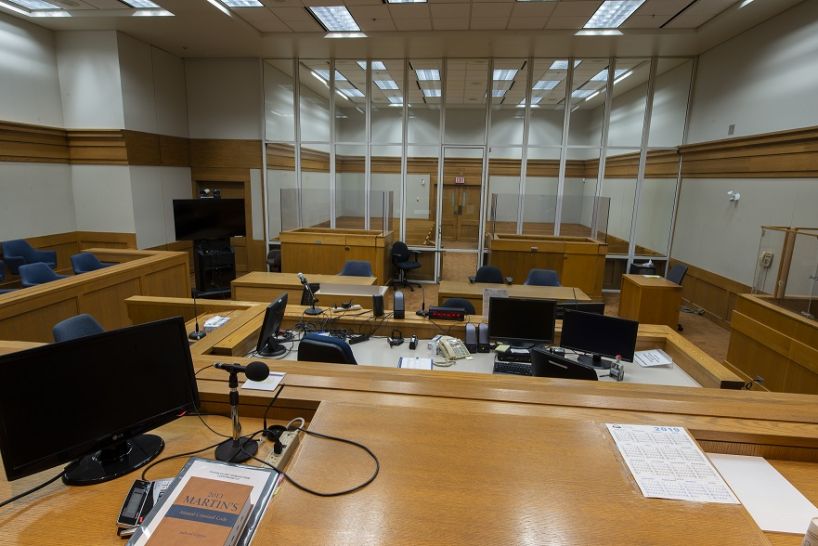Learning your way around a courtroom
Who and what you may see in a courtroom.
Courtroom Layout
The photograph below shows labels for different elements you may see in a courtroom. Explanations for each label are provided below. Not all courtrooms look exactly the same.

Coat of Arms
The coat of arms on the wall of BC courtrooms is the Royal Arms of the United Kingdom. The two mottos featured on the coat of arms are “Dieu et Mon Droit” and “Honi Soit Qui Mal y Pense”.
Judge's bench
The large desk at the front of the room is called the bench or the judge’s bench. The judge or judicial justice sits there during court proceedings. The desk has room for a computer and notebook that they may use to take notes. There is also room for books or binders containing laws and legal reference material. There is no gavel, because Canadian judges do not use gavels.
Canadian judges do not use gavels
Why Canadian judges wear robes
Court clerk
In trials conducted by a judge and in many other court proceedings, a court clerk<p><span lang="EN-US">A Court Services Branch employee who helps the judge inside the court room. Some of their responsibilities include recording the court proceedings, marking and recording the list of exhibits and swearing in witnesses.</span><span> </span></p> sits at the lower desk in front of the judge. Court clerks have many important responsibilities. For example, they make sure that everything that is said in the courtroom is audio-recorded so that transcripts can be produced. A digital clock on the clerk’s desk displays red numbers that show that the digital recording equipment is operating.
The court clerk also takes care of digital and paper case files for cases being heard in the courtroom. Court clerks use a computer to make notes about what happens, including all orders the judge makes. If a litigant offers something (a document, photo or object) as evidence in a trial, the litigant must hand it to the court clerk, not to the judge or witness. The court clerk maintains custody of "exhibits<p><span lang="EN-US">Objects or documents formally presented as evidence in a hearing or trial, accepted by the judge or judicial justice, and given an “Exhibit number” that can be used to refer to it.</span><span> </span></p> of evidence" during the trial and hands them to the witness or judge when necessary.
The court clerk also has a variety of responsibilities for setting up, connecting and facilitating virtual proceedings being held by telephone or video conference.
In some hearings, such as those dealing with traffic ticket offences under BC laws, judicial justices preside without court clerks.
Court clerks are employed by the Court Services Branch of the BC Ministry of the Attorney General.
Witness box
This is where witnesses testify in hearings or trials. The witness box is usually located beside the court clerk’s desk. It usually has a seat with a ledge in front of it to hold papers that the witness may be asked to look at.
Counsel table

Counsel is another word for lawyer. The long table in front of the court clerk’s desk is called the counsel table because the lawyers involved in a case sit there. However, the lawyers’ clients and people conducting their case without a lawyer also sit there too.
Lawyers, as well as people representing themselves, stand by a small podium on the counsel table. They can put their notes on it when they are questioning witnesses or making submissions to the judge.
Participants' chairs
There are usually chairs at the counsel table for lawyers, parties and support persons.
Gallery
Closest to the entrance to a courtroom, there are often rows of seats for spectators and people waiting for a case to be called. The seating area in a courtroom is called the gallery.
Bar
The bar is a barrier separating the seating area (the gallery) from the rest of the courtroom.
The bar has an interesting history. In medieval Europe, courts were held in different locations, including churches, halls, taverns and even outdoors under trees. A wooden barrier (called the bar) identified the space being used for court. When courthouses began to be built in England, they were constructed with a bar dividing the public gallery from the rest of the courtroom. BC courtrooms follow that tradition, with a wooden or bronze railing separating the gallery from the body (the open space) of the courtroom. Some courtrooms have chairs along the front of the bar where lawyers sit while waiting for their case to be called.
The use of the word bar to refer to the legal profession (lawyers) as a whole is thought to be related to the idea of lawyers passing the bar.
Only lawyers and the people involved in a court case may pass through the bar to the working area of a courtroom.
Prisoner’s dock
An accused person who is in custody sits either in the glass-enclosed prisoner’s dock, which is located in a corner or at the centre of the courtroom, or with the judge’s permission, sits beside their lawyer at the counsel table. An accused person who is not in custody sits at the counsel table.
Sheriff

Sheriffs are provincial peace officers responsible for ensuring that courts operate safely and smoothly. Their responsibilities include prisoners’ security and maintaining order in the courtroom under the judge’s direction. There is usually a table in the courtroom for a sheriff.
Native Courtworkers
The Native Courtworker program supports people of First Nations, Metis and Inuit descent both in and out of court, free of charge. Native Courtworkers help clients attend court and follow court orders. They may liaise between clients and lawyers, court staff and community Corrections staff. They may also provide information about community resources for a client at a bail<p><span lang="EN-US">An order made by a judicial justice or a judge releasing an accused person from jail until their trial and requiring them to obey certain conditions (rules) and return to court on a specific date. The legal term for bail is “judicial interim release”.</span><span> </span></p> or sentencing hearing<p><span lang="EN-US">A court hearing where a judge hears submissions from prosecution and defence lawyers about how the offender should be sentenced.</span><span> </span></p>. They do not provide legal advice, but in limited circumstances they might question witnesses in a trial if their client cannot get a lawyer.
Native Courtworker and Counselling Association of British Columbia
Jury box
There is no jury box in the photograph at the top of this page because Provincial Court judges conduct trials without juries. Provincial Court courtrooms do not have jury boxes unless they are shared with the BC Supreme Court.

